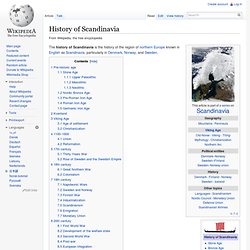

Norsemen. Map showing area of Norse settlements during the 8th to 11th centuries (the Viking Age), including Norman conquests, some extending after this period (yellow).

Trade and raid routes, often inseparable, are marked. Norsemen refers to the group of people as a whole who spoke what is now called the Old Norse language, belonging to the North Germanic branch of the Indo-European languages, especially Norwegian, Icelandic, Faroese, Swedish, and Danish in their earlier forms. Norseman means "people from the North" and applied primarily to Nordic people from southern and central[citation needed] Scandinavia. Norse rituals. Norse pagan worship is the traditional religious rituals practiced by Norse pagans in Scandinavia in pre-Christian times.

Norse paganism was a folk religion (as opposed to an organised religion), and its main purpose was the survival and regeneration of society. Therefore, the cult was decentralized and tied to the village and the family, although evidence exists of great national religious festivals. The leaders managed the cult on behalf of society; on a local level, the leader would have been the head of the family, and nationwide, the leader was the king. Pre-Christian Scandinavians had no word for religion in a modern sense. The closest counterpart is the word sidr, meaning custom. Norse religion was at no time homogeneous but was a conglomerate of related customs and beliefs.
It is not certain to what extent the known myths correspond to the religious beliefs of Scandinavians in pre-Christian times, nor how people acted towards them in everyday life. Worship of the gods[edit] History of Scandinavia. The history of Scandinavia is the history of the region of northern Europe known in English as Scandinavia, particularly in Denmark, Norway, and Sweden.

Pre-historic age[edit] Little evidence remains in Scandinavia of the Stone Age, the Bronze Age, or the Iron Age except limited numbers of tools created from stone, bronze, and iron, some jewelry and ornaments, and stone burial cairns. One important collection that exists, however, is a widespread and rich collection of stone drawings known as petroglyphs. Stone Age[edit] Upper Paleolithic[edit] As the ice receded, reindeer grazed on the flat lands of Denmark and southernmost Sweden.
Mesolithic[edit] In the 7th millennium BC, when the reindeer and their hunters had moved for northern Scandinavia, forests had been established in the land. During the 6th millennium BC, southern Scandinavia was covered in temperate broadleaf and mixed forests. Neolithic[edit] Nordic Bronze Age[edit] Petroglyphs from Scandinavia (Häljesta, Västmanland in Sweden). Norse mythology. An undead völva, a Scandinavian seeress, tells the spear-wielding god Odin of what has been and what will be in Odin and the Völva by Lorenz Frølich (1895) For the practices and social institutions of the Norse pagans, see Norse paganism Norse mythology, or Scandinavian mythology, is the body of mythology of the North Germanic people stemming from Norse paganism and continuing after the Christianization of Scandinavia and into the Scandinavian folklore of the modern period.

The northernmost extension of Germanic mythology, Norse mythology consists of tales of various deities, beings, and heroes derived from numerous sources from both before and after the pagan period, including medieval manuscripts, archaeological representations, and folk tradition. Most of the surviving mythology centers on the plights of the gods and their interaction with various other beings, such as humanity and the jötnar, beings who may be friends, lovers, foes and/or family members of the gods. Sources[edit]